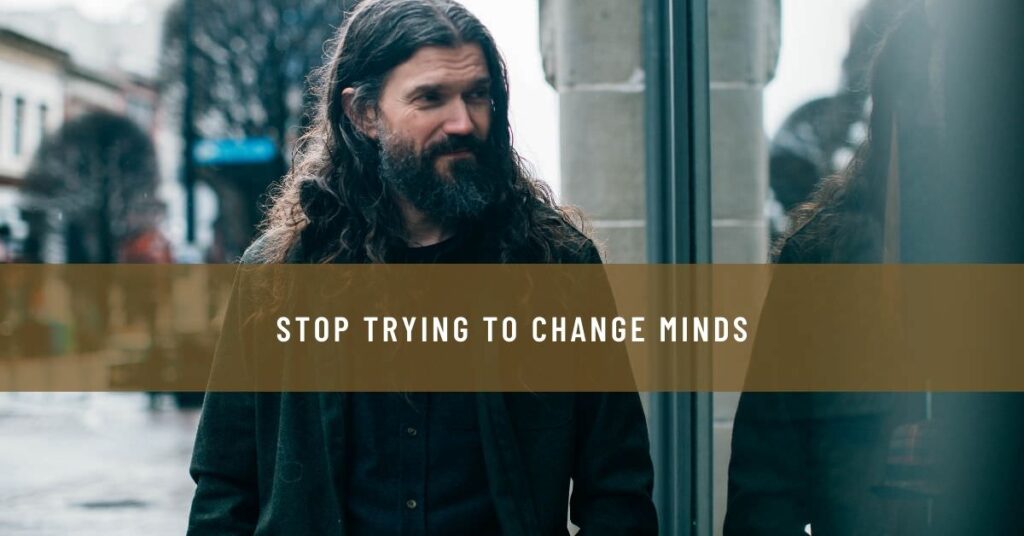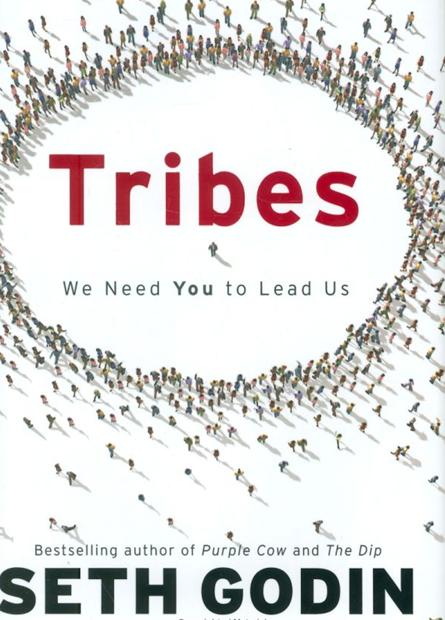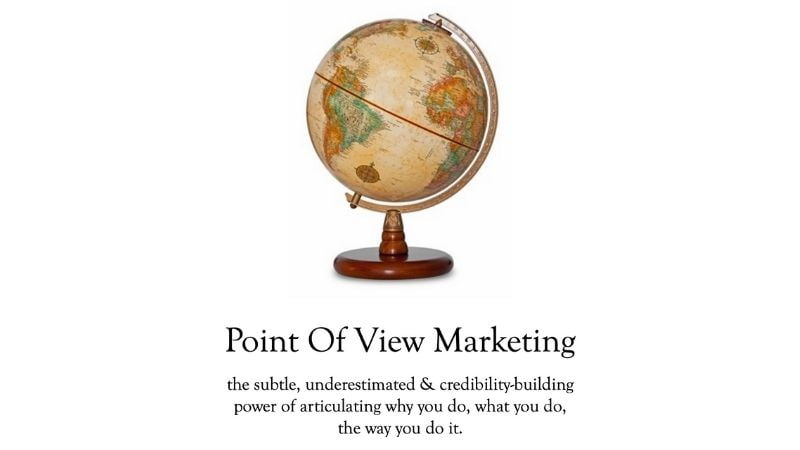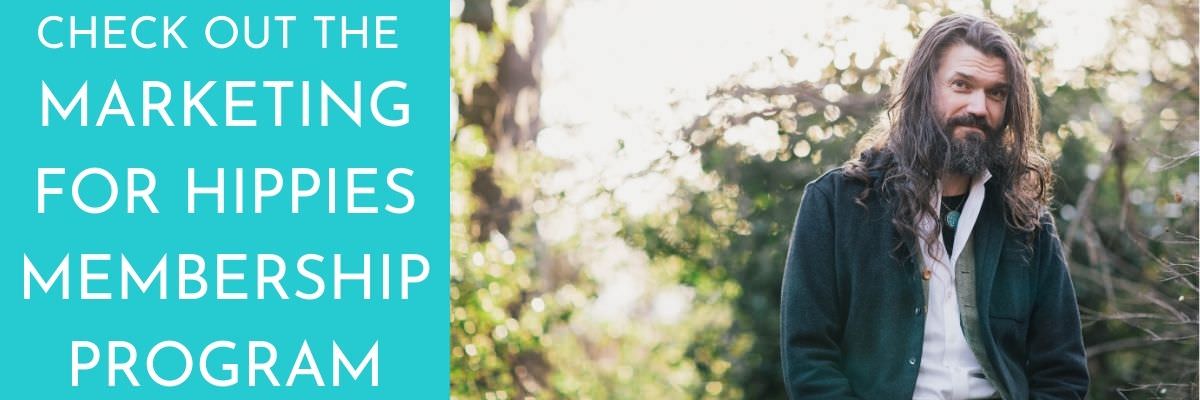I invite you to give up trying to change people’s minds.
People can be a lot like this child – stubborn. They don’t like being pushed around. Or told they’re wrong.
This is the core challenge of marketing I think. Or a core blunder. Or something.
Trying to convince people that we are right and they are wrong.
Trying to convince them that they need to act preventatively.
Trying to convince them that their core world view is wrong.
Trying to convince them that our diagnosis is so important before they even know they have a symptom.
Trying to convince someone to buy NOW when they might rather wait for a more fortuitous timing.
And I want to suggest that . . . that’s really hard.
And it might hurt people.
The idea that we can change people’s minds is the beginning of trouble.
It’s a much better idea to create something that resonates with where people are at. Meet them where they are.
My colleague Jessica O’Reilly shared how she came to this realization with her sex workshops in this blog interview I did with her in July, 2011.
Callan Rush has some important thoughts on this which she shared in this March 2011 blog post. Here’s the relevant excerpt.
LESSON #5: Don’t just market to the 3% who are ready to buy right now.
Think of your ideal clients. The people in your niche. Your target market. Now think of all the people in your town (or wherever you want to tour your workshops) who fit into that group. There are likely a lot of them.
But here’s the bad news.
97% of your ideal clients are NOT looking for my product, program or service right now.
Here’s a piece Callan shared that was worth the whole evening. It’s a percentage break down of your target market right now. I think these percentages are really accurate pretty much across the board:
3% are actively looking for your solution. They’re googling it at 3 am. They are super, actively looking for a solution to their problems. And everyone is fighting over this 3%. Every other workshop leader is trying to reach these same people.
And so they put their marketing out to reach these people.
- “Hypnosis workshop!”
- “Buy our technology”
- “All 2010 Model Cars Must Go! 0% Financing.”
- “Non Violent Communication Workshop”
- “Learn Reiki”.
And it’s not that this kind of marketing doesn’t work. It totally does. It absolutely reaches and works on that 3% of your ideal clients. But it’s ignored by everyone else. Ouch. This means your marketing might be being totally ignored by 97% of your target market.
7% are open to your product, program or service. They’ve heard about the kind of thing you do. They’re genuinely curious about it.
30% are aware for future. They know they need you or someone like you – but it’s sometime down the road. They tell themselves, “I’ll need a new car when we have kids.” But that time hasn’t come yet. Or they think, “When this crunch time at work is over I’m going to get back into yoga.” Or, “When I stop traveling I’m going to buy a house.”
30% are totally unconscious. When you meet them it’s clear that they have a problem you can help them solve – but they have NO awareness they need it. They might not even know they have a problem. It’s like someone with bad breath. You knooooow they need a tick tack but they have no idea. Or someone with anger issues who’s convinced their problem is everyone else.
They may or may not have any overt symptoms but those symptoms are likely not understood. Like, they know they have stomach pains all the time – but they don’t realize that it’s because they’re celiac. Or they notice that their romantic partner has lost interest in them but they don’t see how this loss of interest was triggered by their domineering nature and inability to communicate.
In short, they lack the proper context for their symptoms. And so often they ignore them entirely.
30% are just a ‘NO!’. They’re just closed to it. Maybe it’s because they live too far away, they’ll never be able to afford it or they’ve already hired someone else. With these people you need to just bless and release.
The Bottom Line: 67% of these people are not really being marketed to. They’re being ignored by everyone else leading workshops.
But the way you market to the 67% who are open, aware or unconscious is very, very different than the way you market to people who are totally ready to buy. It’s a bit of a slower turn around. More trust building. More being a generosity based business to start.
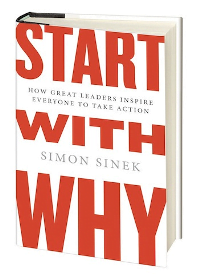
Apple sells a “lifestyle”, marketing professionals will tell you.
Apple didn’t invent the lifestyle, nor does it sell a lifestyle. Apple is simply one of the brands that those who live a certain lifestyle are drawn to. Those people use certain products or brands in the course of living in that lifestyle. That is, in part, how we recognize their way of life in the first place. The products they choose become proof of why they do the things they do. It is only because Apple’s why is so clear that those who believe what they believe are drawn to them. As Harley Davidson fits into the lifestyle of a certain group of people and Prada shoes fit the lifestyle of a certain group, it is the lifestyle that came first. Like the products the company produces that serve as proof of the company’s WHY, so too does a brand or product serve as proof of an individual’s WHY.
That some people are viscerally drawn to a ferrari more than a Honda Odyssey says more about the person than the engineering of the product.
Loyalists for each brand will point to various features and beenfits that matter to them or don’t matter to them in an attempt to convince the other that they are right. And that’s one of the primary reasons why so many companies feel the needs to differentiate in the first place. Based on the flawed assumption that only one group can be right. But what if both parties were right? What if an Apple was right for some people and a PC was right for others? It’s not a debate about better or worse anymore, it’s a discussion about the different needs. And before the discussion can even happen, the WHYs for each must be established first.
A simple claim of better, even with the rational evidence to back it up, can create a desire and even motivate a decision to buy, but it doesn’t create loyalty. It is the cause that is represented by the company, brand, product or person that inspires loyalty.
Seth Godin deepens this conversation is his book Tribes:
A Tribe has a Shared Worldview:
This leads to an interesting thought: you get to choose the tribe you will lead. Through your actions as a leader you attract a tribe that wants to follow you. That tribe has a worldview that matches the message you are sending.
Important clarification: Great marketers lead people, stretching the boundaries and bringing new messages to people who want to hear them. The core of my argument is that someone’s worldview, how they feel about risk or other factors, is beyond your ability to change in the short run. Sell people something they’re interesting in buying. If you can’t leverage the worldview they already have, you are essentially invisible. Which is a whole other sort of magic, one that’s not so profitable.
If you are leading a tribe focused on saving the world by fighting global warming, the tribe will of course have a worldview that includes the idea that global warming is a problem and that it includes the idea that global warming is a problem and that it can be addressed through its actions. They come to the tribe with that in mind and your leadership resonates with them.
If, on the other hand, you choose to work to persuade a different group, one with a very different worldview, they will likely reject you. Al Gore started leading his tribe when he didn’t know who they were.
He stated his message and people found him.
Ultimately, people are most easily led where they wanted to go all along. While that may seem as if it limits your originality or influence, it’s true. Fox News didn’t persuade millions of people to become conservatives, they just assembled a tribe and led them where they were already headed.
Tribes are increasingly voluntary. No one is forced to work for your firm or attend your services. People have a choice of which music to listen to and which movies to watch. So great leaders don’t try to please everyone. Great leaders don’t water down their message in order to make the tribe a bit bigger. Instead they realize that a motivated, connected tribe in the mist of a movement is far more powerful than a larger group could ever be.
As the ability to lead a tribe becomes open to more people, it’s interesting to note that those who take that opportunity (and those who succeed most often) are doing it because of what they can do for the tribe, not for what the tribe can do for them.
This is the heart of the matter: Every leader cares for and supports a movement. A movement like the free speech movement at Berkeley or the democracy movement in Tiananmen Square or the civil rights movement in Mississippi. Or maybe a movement like the obsession with hand roasted coffee in Brooklyn or the worldwide collection of people obsessed with tattoos.
Today, you can have a narrow movement, a tiny movement, a movement in a silo. Your movement can be known by ten or twenty or a thousand people, people in your community or people around the world. And most often, it can be the people you work with or for, or those who work for you.
The web connects people. That’s what it does. And movements take connected people and make change. What marketers and organizers and people who care are discovering is that they can ignite a micromovement and then be propelled by the people who choose to follow it.
The bottom line is this: don’t try to change people’s minds. Get so clear about your deeper why, the journey you help people on best and your point of view and find people who will resonate with that. Don’t try to get people to change their minds about things. Meet them where they are and begin to slowly educate. Find some real challenge they are aware of that they’re experiencing and offer them help with that. Earn the trust. Align and then redirect – don’t oppose.
Instead of trying to push harder and hype it up more – just make it clearer who you are and safer for people to approach you. Be the lighthouse, not the searchlight.
